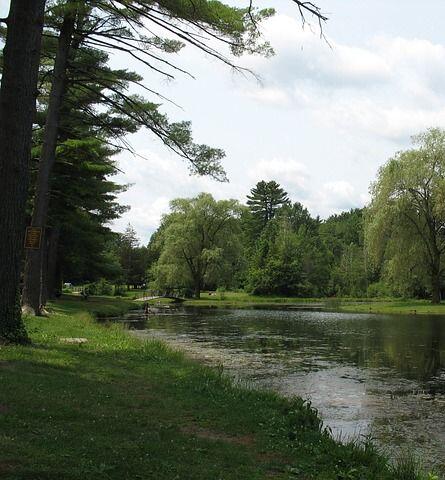Common Pond problems in Upstate New York can be effectively managed by maintaining proper water quality, controlling algae, addressing fish health, managing invasive plants, and monitoring water levels.
Owning a pond in Western and Central New York is an enjoyable experience, but like any outdoor feature, it comes with its own set of challenges. The fluctuating climate and seasonal changes can lead to a variety of common pond problems. From algae overgrowth to fish health issues, these problems can disrupt the balance of your pond if not addressed properly. Fortunately, understanding the common pond problems in the area and how to tackle them can help keep your pond healthy and visually appealing year-round.

Algae Blooms: Tackling Overgrowth
Algae blooms are one of the most common pond problems faced by homeowners in Upstate New York, especially during the warmer months. Algae thrive in ponds that have excess nutrients in the water, often from organic matter like fallen leaves, decaying plants, or overfeeding fish. The result is murky, green water that not only looks unappealing but also threatens the health of aquatic life by depleting oxygen levels.
The best way to control algae is to limit the amount of nutrients available for growth. Regularly clean your pond by removing leaves, twigs, and other debris. Ensure that your pond has a proper filtration system that circulates the water and promotes oxygenation. Installing aerators or waterfalls can also help, as the movement of water reduces the stagnant conditions that algae thrive in. In more severe cases, using natural probiotic pond treatments such as barley straw can help limit algae growth without harming the ecosystem. These treatments work by blocking sunlight and stabilizing nutrient levels, preventing algae from proliferating.
Murky Water: Restoring Clarity
Another common issue pond owners face is murky or cloudy water, which can be caused by a number of factors, including excess nutrients, suspended particles, or an imbalance in the pond’s ecosystem. Murky water can make it difficult to enjoy the beauty of the pond and can also create unhealthy conditions for fish and plants by limiting sunlight and oxygen.
To solve this issue, start by improving filtration. Ensure your filter is appropriately sized for the pond’s volume and that it is cleaned and maintained regularly. Additionally, adding beneficial bacteria to the water can help break down organic material and clear up the water naturally. This bacteria feeds on excess nutrients and reduces the presence of suspended particles.
Fish Health Issues: Preventing Stress and Disease
Fish health is another area where pond owners often run into problems. Stress from poor water quality, extreme temperature fluctuations, and overcrowding can make fish more susceptible to disease. In addition, parasites like ich or skin conditions can become a problem in ponds that are not well-maintained. Signs of unhealthy fish can include unusual swimming patterns, lesions, or sudden deaths.
To avoid these issues, it’s important to regularly test your pond water for essential parameters such as pH, ammonia, nitrites, and nitrates. Keeping water conditions stable and within a healthy range is one of the most effective ways to prevent disease. Make sure your fish have plenty of space to swim and are not overcrowded, as this can lead to stress and make them more vulnerable to illness. If you notice any signs of disease, quarantine affected fish and treat them separately.
Invasive Plants: Controlling Overgrowth
While aquatic plants are essential for maintaining a healthy pond ecosystem, invasive species can become a significant problem. Plants like water hyacinth or water lettuce can grow quickly and take over large sections of the pond, choking out native species, blocking sunlight, and reducing oxygen levels in the water. These plants can also create an imbalanced environment that leads to poorer water quality.
To manage invasive plants, it’s important to regularly monitor and remove them. Manual removal of invasive species is often necessary, as they can spread quickly and overwhelm the pond. Additionally, you can prevent these plants from taking hold in the first place by choosing native, non-invasive species when landscaping your pond. Native plants are better suited to the local climate and won’t grow out of control.
Water Level Fluctuations: Managing Seasonal Changes
Water level fluctuations are another common problem in Western New York, where heavy rainstorms, melting snow, or droughts can cause the water levels in ponds to rise or fall dramatically. High water levels can lead to overflow and erosion, while low water levels can stress plants and fish and disrupt the pond’s ecosystem.
To manage fluctuating water levels, regularly monitor the pond’s depth, especially after periods of heavy rain or dry weather. Installing a pond liner or improving drainage systems can help control water levels and prevent overflow. During dry spells, using a pump to top off the water level can help prevent the pond from drying out. On the flip side, during wet conditions, creating overflow areas or ensuring proper drainage can prevent erosion and keep the pond from overflowing.
Conclusion
Owning and maintaining a pond in Western New York presents its fair share of challenges, but with the right approach, most common pond problems can be addressed effectively. By staying on top of algae growth, maintaining good water quality, protecting fish health, controlling invasive plants, and managing water levels, you can ensure that your pond remains a beautiful and healthy feature throughout the year. Regular maintenance and monitoring are key to avoiding these common pond problems, allowing you to enjoy your outdoor space without unnecessary stress.
